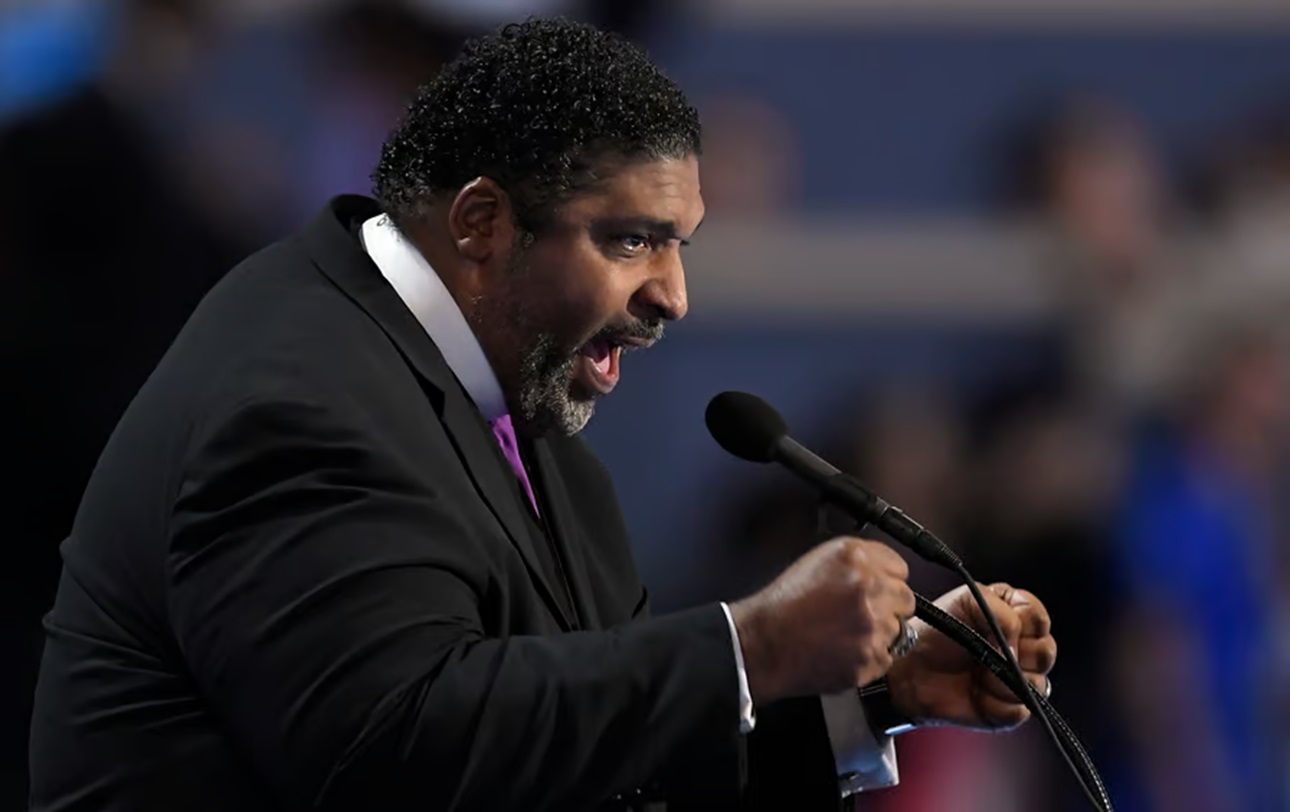
CHICAGO—“Moral fusion” crossing racial lines, will be a key feature of the Poor People’s Campaign during and after this fall’s election, campaign co-chair, the Rev. William Barber II says. And along the way, he declares, it’ll try to dispel a lot of American myths.
Barber told an August 21 press conference here, during the Democratic National Convention, that myths pigeonhole the poor. As a result, they hamper the drive to lift the economic and political powerlessness of the estimated 140 million poor and low-wealth people nationwide.
Though Barber did not specifically name names about who create and perpetuate the myths, his message was clear: The ruling class does so to keep its political and dollar advantage. And it’s not as simple as a liberal-moderate-conservative division, though that, too, represses the poor.
Such political stereotyping also lets politicians ignore the needs of the poor, he said. But it can be at their peril if more poor people register and vote. The campaign aims to register millions of more poor people this fall and will concentrate its campaigning on 15 states, some of them now swing states and others that could become swing in the voting.
And all, including North Carolina, Georgia, Florida, Pennsylvania, Michigan, Alabama, and Ohio, share two common characteristics. One is more than four of every ten people are poor and low-wealth in each state. The other is the poor don’t vote “because politicians don’t talk to them.”
But since the campaign talks about issues rather than political personalities, it first must dispel myths in order to toil effectively, Barber explained.
In a step towards what Barber discussed, Democratic presidential nominee Kamala Harris disclosed in a tweet that she would, on her first day in office, move to cap annual increases in rent nationwide. The most often discussed figure is 5%.
“Myths can be powerful” and they can hold people back, Barber elaborated. “Some of us went to sleep because of myths.” Sleepers can wake up “to find we are in the midst of the birth of a Third Reconstruction,” he predicted.
The first such big change was the original post-Civil War Reconstruction, which ended with a “compromise” over the presidency in 1877 and a subsequent U.S. Supreme Court ruling legalizing “separate but equal” treatment of whites and Blacks. That was certainly separate but also definitely unequal. The second was the Civil Rights revolution of the 1960s. Both ended with a backlash from people influenced by racism.
“The mythology of American exceptionalism is dangerous,” Barber declared. “The myth that skin color determines brain size”—Blacks have “smaller” brains, it says—“is dangerous. The myth of racism is bad biology and sick sociology. The myth of the end justifies the means produces an evil economy. And Jesus preached that you can’t have evangelism without starting by helping the poor.
“We have to expand the view of economics to cover systemic racism,” Barber explained. “For instance, denial of Medicaid expansion in North Carolina,” his current home state, “denied health care to 500,000 people: 350,000 were whites, 150,000 were Blacks and 30,000”—of all races—“were soldiers.”
Those soldiers were impoverished by “the war economy, which even a Republican president, Dwight Eisenhower, blamed on the military-industrial-congressional-complex. Then he took out the word ‘congressional.’” But the military continues to consume an ever-increasing share of federal spending, and does so with bipartisan congressional support, he noted.
Campaigning against the war economy is a key plank in the Poor People’s platform. The billions that would save, Barber and his allies state, should go to improving housing and education for poor and low-wealth people and combating global climate change, among other goals.
And the moral fusion of white poor and low-wealth people with Black, Latino, and Native American colleagues can both overcome the myths and produce the votes to change the political course of the U.S., he said. That includes changing the priorities of the country, as the campaign desires.
“Sixty percent of Black people are poor or low-wealth, but in sheer numbers, 66 million, or 26%, are white.” Latinos and Native Americans have slightly higher percentages of the poor among their ranks.
Moral fusion, overcoming the efforts of the elite to divide people by race and class, has occurred before, Barber noted. In one case, a Kentucky woman told him white and Black workers fought together against West Virginia’s governor in the famous Blair Mountain Wars of 1922. The governor called in troops and dropped bombs on striking coal miners, who included her grandfather—and his.
The Democratic platform, which convention delegates approved the day before, contains a pledge by presidential nominee Kamala Harris to take on poverty in the U.S., starting by combatting corporate greed which is raising people’s rents and home prices. Speakers at a convention panel on poverty proposed other initiatives.
But it is silent about the systemic poverty Barber discussed in the press conference and Dolores Huerta, the Farm Workers’ president emerita denounced at the panel session. She blamed capitalism for creating it. Indeed, the words “systemic poverty” and “systemic racism” are absent from the platform. And the last time the Democrats discussed one particular solution—making homes and rental apartments more affordable—was in 1972, Barber noted.
“We start with the answer—calling out the crisis” of myths that distort America “and then moral fusion can be the force to stop it,” he concluded.
The press conference was livestreamed here.
We hope you appreciated this article. At People’s World, we believe news and information should be free and accessible to all, but we need your help. Our journalism is free of corporate influence and paywalls because we are totally reader-supported. Only you, our readers and supporters, make this possible. If you enjoy reading People’s World and the stories we bring you, please support our work by donating or becoming a monthly sustainer today. Thank you!










